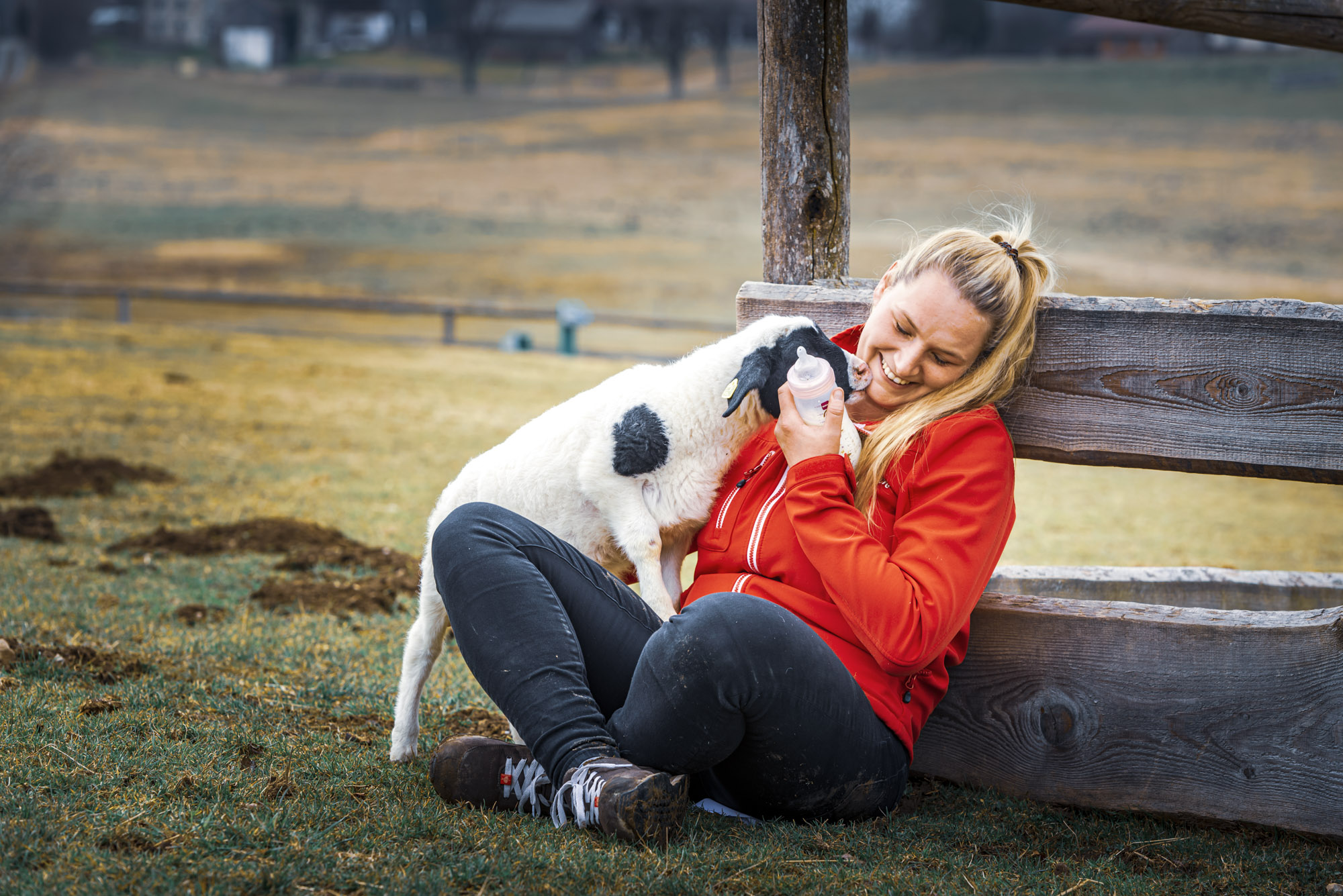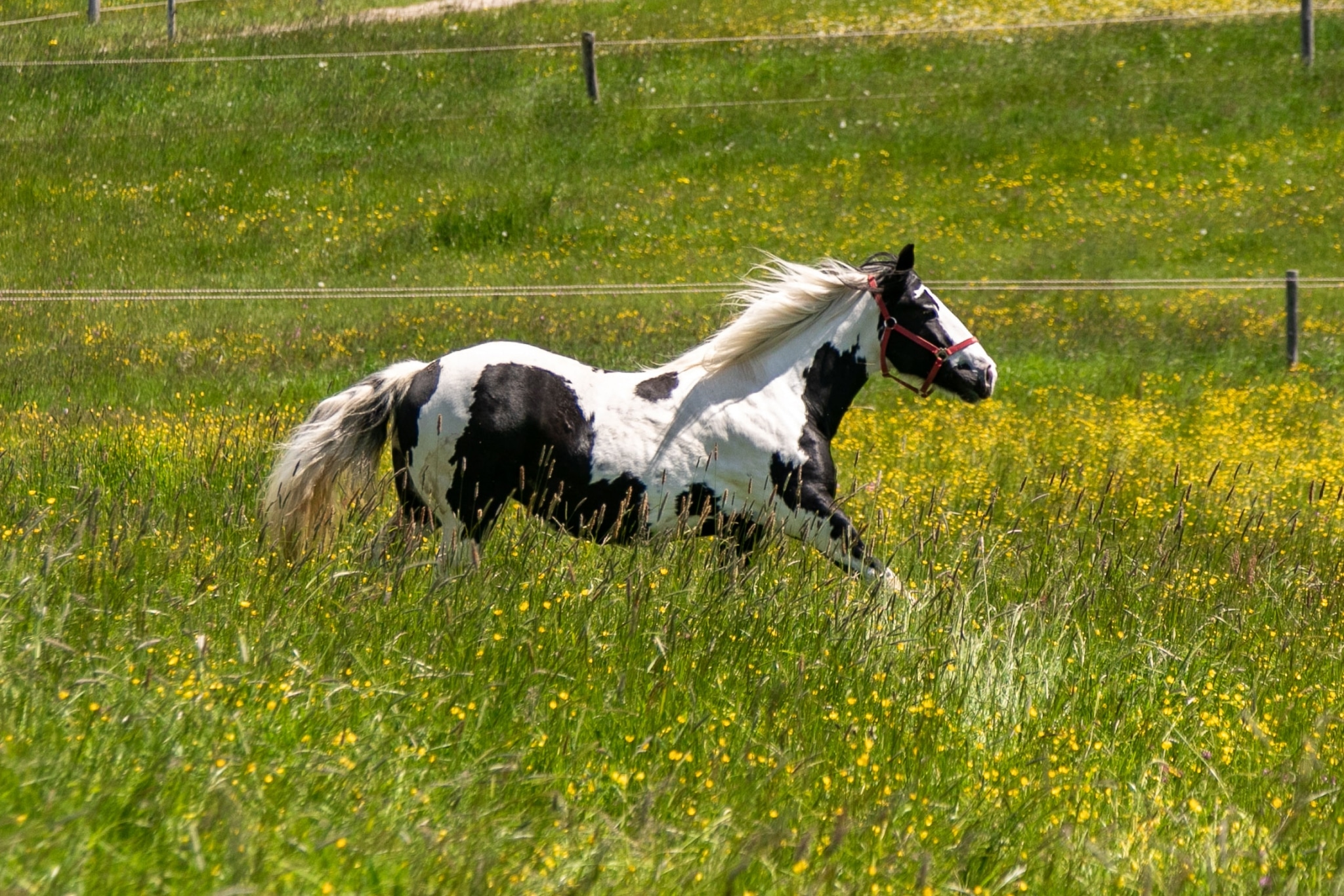
Pferdegesundheit
Um die Bedürfnisse alternder oder chronisch kranker Tiere verstehen und ihnen eine bessere Lebensqualität ermöglichen zu können, bedarf es einer näheren Betrachtung der Pferdegesundheit. In Kombination mit modernen, aber auch alternativen Behandlungsmethoden werden physische und physiologische Gesundheits-Faktoren bei alten Pferden beobachtet. Die Lebensqualität von geretteten Pferden auf Gut Aiderbichl kann somit nachhaltig sichergestellt werden.
Die Population älterer Pferde wächst weltweit. Die Alterung ist aber mit physischen und physiologischen Veränderungen verbunden. Die Entwicklung der Mikrobiota, die den Hinterdarm bewohnt, ist während dieses Alterungsprozesses bis heutzutage wenig erforscht. Da diese Mikrobiota eine wesentliche Rolle bei der Verdauung von Fasern, der Unterstützung des Stoffwechsels und einer angepassten Immunität spielt, ist es notwendig, eine „gesunde Mikrobiota“ zu erhalten.
Ziel des Projekts „Gesundes Altern“ ist es, das Wissen über die Seneszenz der Mikrobiota des Pferdedarms und die damit verbundenen Verdauungs-, Stoffwechsel- und Immunfunktionen zu erweitern. Die gewonnenen Erkenntnisse sollen es ermöglichen, Empfehlungen, insbesondere Ernährungsempfehlungen, zur Erhaltung der Gesundheit und des Wohlbefindens des Pferdes im Alter zu erarbeiten.
Auswirkungen des Alterns auf die Hinterdarmflora von Pferden
Verständnis der Auswirkungen des Alterns auf das fäkale mikrobielle Ökosystem, um das gesunde Altern von Pferden zu fördern
Grundlage/Ausgangspunkt: Der Dickdarm des Pferdes beherbergt Millionen verschiedener Mikroorganismen, die für die Verdauung und Energiebereitstellung eine wesentliche Rolle spielen. Unter dem Einfluss von Umwelt- oder intrinsischen Faktoren können Veränderungen in der Mikrobiota des Dickdarms auftreten, die die Gesundheit und/oder das Wohlbefinden des Pferdes verschlechtern können. Als einer dieser Faktoren sind das Altern, wobei seine Auswirkungen auf das Mikrobiota bis heute wenig bekannt. Nur wenige vorhandene Informationen berichten von einer Abnahme der bakteriellen Diversität bei Pferden mit zunehmendem Alter, was tatsächlich mit Daten beim Menschen übereinstimmt. Eine solche Abnahme kann zu einer geringeren Widerstandsfähigkeit des mikrobiellen Ökosystems gegenüber Umwelt-belastungen führen. Zudem sind zu wenige Informationen über die Entwicklung der Effizienz der Rohfaserverdauung beim Pferd mit zunehmendem Alter bekannt, die für die Energiebereitstellung, die Verdauungsgesundheit und folglich den allgemeinen Gesundheitszustand des Tieres entscheidend ist.
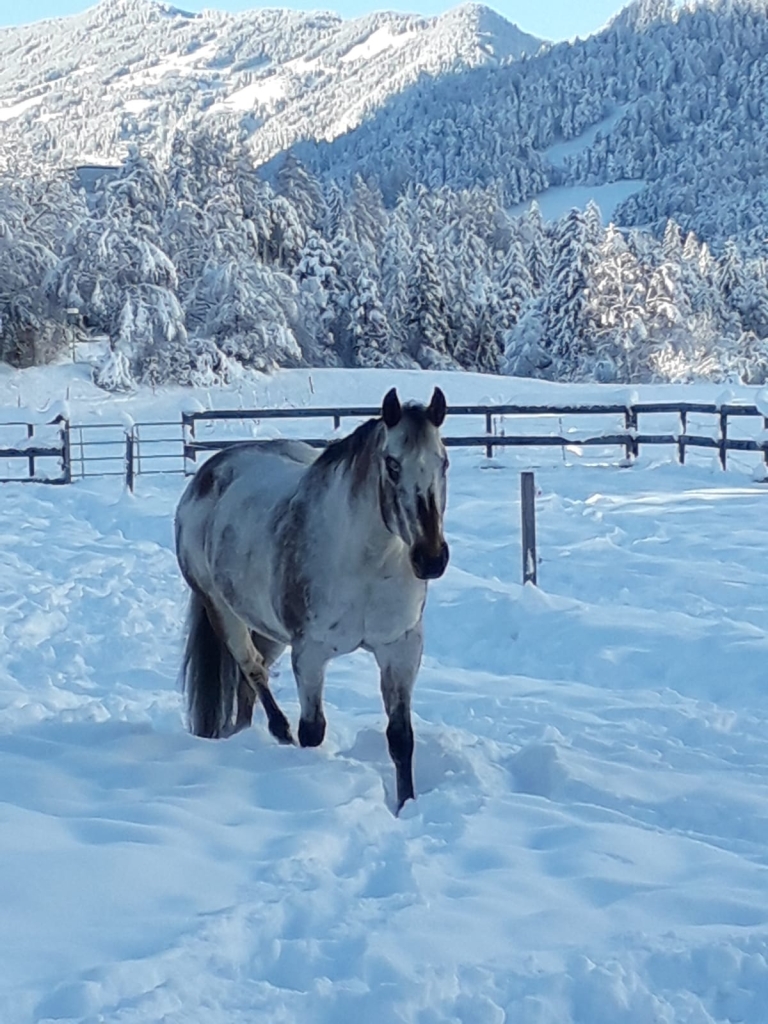
Ziel: Ziel des Projektes war es, die mit dem Alter auftretenden Veränderungen der fäkalen Mikrobiota bei Pferden zu untersuchen. Dies führte zu: (1) der Untersuchung der altersbedingten Entwicklung der bakteriellen Zusammensetzung der fäkale Mikrobiota und (2) zur Bewertung der Auswirkungen dieser Veränderungen auf die Verdauung. Um diese Fragen zu beantworten, wurden 50 Pferde im Alter zwischen 6 und 30 Jahren unter dem gleichen Fütterungsregime überwacht, Kotproben genommen und analysiert.
Neue Erkenntnisse: Verschiedene Kotparameter, die auf Bakterienaktivität hinweisen, wurden vom Alter beeinflusst, wobei die Unterschiede zwischen älteren Pferden (≥26 Jahre alt) und jüngeren Pferden stetig zunahmen und höchst waren. Diese Ergebnisse deuten auf hochgradige altersbedingte Veränderungen in der Verdauung hin, die möglicherweise durch die Zusammensetzung und/oder Aktivitätsänderung der Mikrobiota verursacht werden. Die Bakterienstruktur im fäkale Ökosystem – derzeit untersucht – wird ergänzende Informationen zum Verständnis der Verdauungsentwicklung des Dickdarms des Pferdes mit zunehmendem Alter liefern.
Ausblick: Die Ergebnisse zur Veränderung der fäkalen bakteriellen Mikrobiota mit zunehmendem Alter werden dazu beitragen, Haltungsempfehlungen für Pferde vorzuschlagen, die an ihr Alter angepasst sind, insbesondere Fütterungsanpassungen. Die beobachteten Veränderungen in der fäkalen Mikrobiota eröffnen Perspektiven für das Verständnis der Verursacher Mikrobiota-vermittelter Krankheiten bei älteren Pferden. Mit weiteren Erkenntnissen könnte dies dazu führen, das gesunde Altern des Pferdes zu fördern.
Publikation:
Diese Arbeit wurde 2021 auf dem Symposium der Equine Science Society vorgestellt:
Buttet, M., Omphalius, C., Milojevic, V., Julliand, V., & Julliand, S. (2021). Assessment of the impact of age on fecal microbial ecosystem in horses. Journal of Equine Veterinary Science, 100, 103474. https://doi.org/10.1016/J.JEVS.2021.103474
Eine peer-review Publikation ist in Vorbereitung und wird voraussichtlich bis Ende 2022 erscheinen.
Projektleitung: Lab to Field
Fütterungsmanagement um das gesunde Altern zu fördern
Altersabhängige Veränderung der Darmmikrobiota, der Verdauung und niedriggradige Entzündungen bei Pferden – Wie kann man durch Fütterungsmanagement ein gesundes Altern fördern?
Grundlage/Ausgangspunkt: Die Population alternder Pferde hat in den letzten Jahrzehnten weltweit zugenommen. Dieser Trend kann einer Veränderung wichtiger physiologischer Funktionen gegenüberstehen und zu einer Veränderung des allgemeinen Gesundheitszustands führen. Die ständige Interaktion zwischen Darmmikrobiota und Immunsystem betont die Wichtigkeit des Verständnisses dieser Funktionen unter dem Einfluss des Alterns. Es wurde bereits gezeigt, dass bei alternden Pferden ein Immunoseneszenz-Phänomen auftritt und dieser Immunitätsverringerung einem chronischen, niedriggradigen, systemischen und asymptomatischen Entzündungszustand (als Entzündungsaltern oder inflammaging genannt) gegenübersteht. Basierend auf den Vorstudie Ergebnissen, die Unterschiede in den Kotparametern zwischen erwachsenen und Pferden über 26 Jahren beweisen, könnten die beobachtete Mikrobiotaveränderungen schwere Folgen haben, insbesondere bei älteren Pferden die Stoffwechselstörungen öfter entwickeln.
Da die Ernährung einer der wichtigsten Faktoren für die Funktionsvielfalt der Mikrobiota ist, und leicht angepasst werden kann, wurde beschlossen zu untersuchen, wie das Fütterungsmanagement die Darmmikrobiota bei älteren Pferden und die damit verbundenen Verdauungs- und Immunfunktionen begünstigen könnte. Dies hat die Einrichtung dieses Projekts motiviert, um ein gesundes Altern beim Pferd zu fördern.
Ziel: Ziel des Projektes ist es festzustellen, ob sich die fibrolytische (Rohfaserverdauungs-) Kapazität und das Entzündungsaltern (inflammaging) entsprechend den altersbedingten Veränderungen der Mikrobiota entwickeln. Dies wird Folgendes umfassen:
- Vergleich der Abbaueffizienz von Rohfasern bei alten gegen erwachsene Pferde,
- Untersuchung der Zusammenhänge zwischen der Zusammensetzung und Aktivität der Mikrobiota, der Rohfaserverdauung und der leichten Entzündung bei alten und erwachsenen Pferden,
- Relevante Biomarker identifizieren, die leicht verwendbar sind, um altersbedingte Veränderungen nachzuverfolgen
- Verschiedene Fütterungsregime für ältere Pferde vergleichen, um die geeignetste zu bestimmen.
Um diese Ziele zu erreichen, werden von 2021 bis 2023 drei Studien in Frankreich durchgeführt.
Neu Erkenntnisse: Die Ergebnisse der ersten Studie, die im ersten Halbjahr 2022 durchgeführt wurde, werden derzeit analysiert. Diese Daten werden bis Ende 2022 vorliegen.
Ausblick: Basierend auf den Ergebnissen zu Veränderungen der Mikrobiota, der fibrolytischen und der Immunfunktion werden Pferdebesitzern überarbeitete und wissenschaftlich fundierte Fütterungs-empfehlungen zur Verfügung gestellt. Dies zielt darauf ab, die Gesundheit und das Wohlbefinden der ältesten Pferde zu fördern, aber auch das Fütterungsmanagement zu optimieren, damit die Pferde in der „Senior-Kategorie“ gesünder bleiben.
Publikation: Diese Arbeit wird durch wissenschaftliche Kommunikationsmittel (internationale Konferenzen und peer-review Publikationen) und durch Popularisierungsartikel für Pferdebesitzer präsentiert.
Projektleitung: Lab To Field, Institut Agro Dijon – UMR PAM, Prof. DVM, PhD, Veronique Julliand
Projektname: Behandlung equiner Hauttumore mit Betulinsäure mit Hilfe transkutaner Applikationsmethoden
Grundlage/Ausgangspunkt: Das Equine Maligne Melanom (EMM) gehört zu einem der häufigsten Hauttumore beim Pferd und kommt am häufigsten bei weißen Pferden (Schimmeln) vor. Bis zu 80 % der über 15-jährigen Schimmel erkranken am malignen Melanom. Die Tumore sind vor allem an der Schweifrübe, im Perianalbereich, an den Genitalien, Augenlidern, der Lippe, der Ohrspeicheldrüse oder den Luftsäcken zu finden. Dabei zeigen sie ein langsames, verdrängendes Wachstum und neigen im fortschreitenden Stadium zur Metastasierung in die inneren Organe. Die Beschwerden für die erkrankten Tiere sind zunächst mechanischer Natur (Probleme beim Kot- oder Harnabsatz, Futteraufnahme, Lidschluss u.v.m.), können aber im weiteren Verlauf die Lebensqualität der Pferde stark einschränken und durch die Metastasierung auch weitreichende Probleme verursachen.
Für die Behandlung des EMM gibt es bisher keine Standardtherapie. Derzeit werden die Tumore meistens operativ oder chemotherapeutisch behandelt. Bei kleinen Tumoren zeigen diese Behandlungsmethoden teilweise Erfolge, die Prognose für größere Tumore ist jedoch deutlich schlechter. Zudem birgt die Gabe von Chemotherapeutika Risiken für das behandelte Tier, die behandelnden TierärztInnen sowie die PferdebesitzerInnen.
Ziele: Das Ziel dieser Studie ist es, eine neue, lokale Behandlungsmethode zu finden, welche effektiv, aber auch sicher für das behandelte Tier, die behandelnden TierärztInnen und TierbesitzerInnen ist. Außerdem soll die Therapiemethode einfach durchzuführen und nicht-invasiv sein.
Die Betulinsäure ist ein natürlich vorkommender, aus der Rinde von Birken und Platanen gewonnener sekundärer Pflanzenstoff. Betulinsäure und das Derivat NVX-207 hemmen das Wachstum von Melanomzellen und besitzen u.a. entzündungshemmende, antivirale und wundheilungsfördernde Eigenschaften.
Da beide Wirkstoffe bereits in mehreren Studien vielversprechende Ergebnisse zur Behandlung von EMM hervorbrachten, werden diese Wirkstoffe weiter untersucht. Dazu werden die Konzentrationen der Wirkstoffe in neuen Mikroemulsionsgelen erhöht, um die Hautbarriere besser zu überwinden und somit höhere Wirkstoffkonzentrationen in der Haut zu erzielen.
Ergebnisse/neue Erkenntnisse: Die zu untersuchenden Substanzen werden zunächst unter Laborbedingungen getestet. Dabei wird getestet, ob die auf die Haut aufgetragenen Wirkstoffe entweder gelöst in der Mikroemulsionsgel oder mit Hilfe eines transdermalen sauerstoffgestützten Applikationsart ausreichende Konzentrationen in der Haut erreichen. Erste Ergebnisse zeigen, dass die gewünschten Wirkstoffkonzentrationen in der Haut bei allen getesteten Substanzen und beiden getesteten Applikationsmethoden erzielt werden konnten.
Ausblick: Ziel dieser Studie ist es, am Equinen Malignen Melanom erkrankte Pferde erfolgreich mit diesen neu entwickelten Behandlungsmethoden zu therapieren.
Zurzeit erfolgt die Auswertung, um zu entscheiden, welche der getesteten Substanzen an den erkrankten Pferden angewendet werden. Der Behandlungsversuch der erkrankten Pferde wird in der Rehastation für Pferde in der Schweiz durchgeführt. Die Vorbereitungen dafür erfolgen derzeit.
Projektleitung: Dr. med. vet., DVM-PhD Karina Klein, Prof. Dr. med. vet. Jessika-M. V. Cavalleri
Melanome im Bereich der Maulspalte ; im Bereich der Ohrspeicheldrüse; im Perianalbereich und an der Schweifrübe
© Fotos: Paula Zscherpe
Forschungsplattform setzt sich die intensive Zusammenarbeit und Austausch zwischen Gut Aiderbichl und der Vet. Med. Universität Wien im Bereich der Erforschung ethisch relevanter veterinärmedizinischer Aspekte der Mensch-Pferd-Beziehung zum Ziel. Dabei stehen insbesondere Entscheidungsfindungsprozesse und ihre Kriterien sowie notwendige Therapieentscheidungen, angesichts alter und/oder chronisch kranker Tiere im Vordergrund. Die interdisziplinären Projekte der Forschungsplattform nähern sich dem komplexen Thema der Lebensqualität von Pferden aus verschiedenen Perspektiven, um gute Entscheidungen für die Pferde auf Gut Aiderbichl und darüber hinaus unterstützen zu können.
Lebensqualität bei alten und chronisch kranken Pferden
Grundlage/Ausgangspunkt: Obwohl die Lebensqualität seit vielen Jahren als Entscheidungshilfe für die Behandlung und Euthanasie von Tierpatienten herangezogen wird, gibt es derzeit keine allgemein anerkannte Definition der Lebensqualität bei Pferden, keinen Konsens über die Faktoren, die zur Lebensqualität von Pferden beitragen, und keine etablierte Methodik für ihre Bewertung.
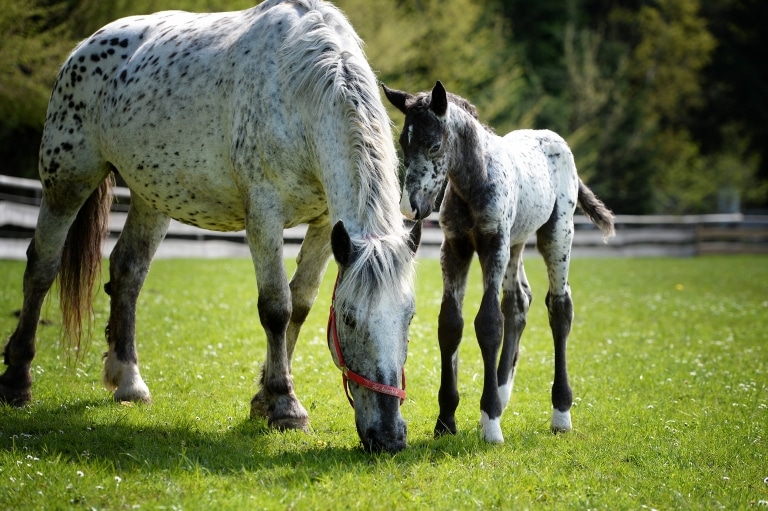
Ziele: Ziel dieses Projekts ist die Entwicklung eines Untersuchungsschemas zur Bewertung der Lebensqualität von Pferden und zur Entscheidungsfindung im Hinblick auf tierärztliche Interventionen bei geriatrischen und/oder chronisch kranken Pferden.
Ergebnisse/Neue Erkenntnisse: Im Rahmen der Studie werden die Pferde von Gut Aiderbichl über Jahre regelmäßig untersucht. Während jeder Untersuchungsperiode sind die Pferde über 5-10 Tage mit einem tragbaren Sensor ausgestattet. Die Sensoren zeigen auf wie viel Zeit die Pferde mit verschiedenen Aktivitäten, wie Fressen, Ruhen, Liegen oder Bewegung, verbringen. Während der Untersuchungsperiode werden die Pferde auch tierärztlich untersucht, somit können die Abweichungen in den Messdaten mit gesundheitlichen Veränderungen verbunden werden.
Ausblick: Abweichungen in den Messdaten, z.B. in den Fresszeiten oder in den Liegezeiten, oder Verhaltensänderungen, Veränderung in der Körperhaltung, sowie ein sichtbar Schmerzgesicht können ein Hinweis auf (gesundheitliche) Probleme sein. Die Pferde eine genauere Untersuchung, um die Ursache der Abweichung zu finden und maßgeschneiderte Interventionen, wie z.b. Haltungsoptimierung oder medizinische Therapie zu entwickeln um das Wohlbefinden des Pferdes zu verbessern.
Publikationen: Auer U, Kelemen Z, Engl V, Jenner F. Activity Time Budgets-A Potential Tool to Monitor Equine Welfare? Animals (Basel). 2021 Mar 17;11(3):850. doi: 10.3390/ani11030850.
Kelemen Z, Grimm H, Long M, Auer U, Jenner F. Recumbency as an Equine Welfare Indicator in Geriatric Horses and Horses with Chronic Orthopaedic Disease. Animals (Basel). 2021 Nov 8;11(11):3189. doi: 10.3390/ani11113189.
Kelemen Z, Grimm H, Vogl C, Long M, Cavalleri JMV, Auer U, Jenner F. Equine Activity Time Budgets: The Effect of Housing and Management Conditions on Geriatric Horses and Horses with Chronic Orthopaedic Disease. Animals (Basel). 2021 Jun 23;11(7):1867. doi: 10.3390/ani11071867.
Projektleitung: Hon.-Prof. Univ.-Prof. Dr. Herwig Grimm, Dipl.ACVS Univ.-Prof Dr med.vet. Dipl.ECVS Jenner Florien
Ethik der Entscheidungen am Lebensende von alten und/oder chronisch kranken Pferden
Grundlage/Ausgangspunkt: Die einfache Frage „Wie geht es meinem Pferd?“ stellt vor große Herausforderungen. Wie kann man sich in das Pferd hineinversetzen und woher kann man wissen, dass man bei der Einschätzung der Lebensqualität richtig liegt? Das Projekt befasst sich mit der Lebensqualität bei chronisch kranken und alten Pferden vor dem Hintergrund zunehmender Möglichkeiten in der Veterinärmedizin und den damit verbundenen Fragen nach der Angemessenheit von Therapien am Lebensende von Pferden.
Obwohl Lebensqualität als wichtiges Entscheidungskriterium für Therapien und für die Euthanasie von Relevanz ist, ist es ein Konzept ohne klare Definition und darüberhinaus in der Praxis komplex zu bewerten. Zudem gibt es meist mehrere Beteiligte mit unterschiedlichen Herangehensweisen und Beziehungen zum Pferd, wie Pferdebesitzer:in und Tierärzt:in, die nicht immer einer Meinung sind, wie es mit einem Pferd am besten weitergehen sollte.
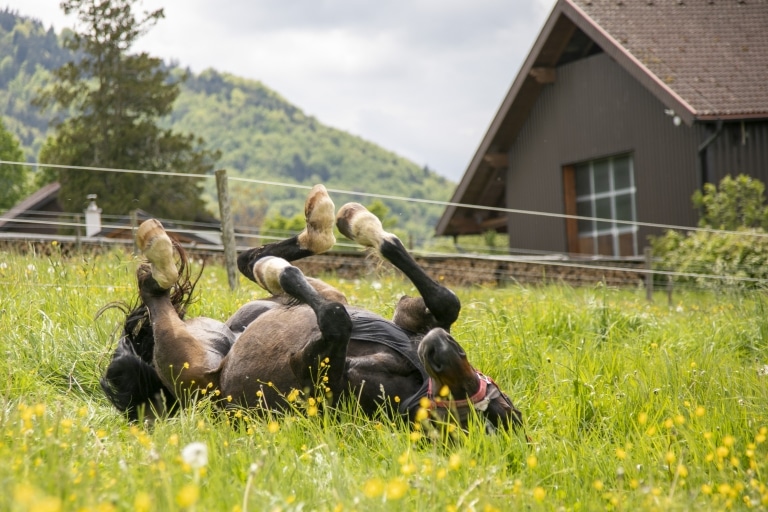
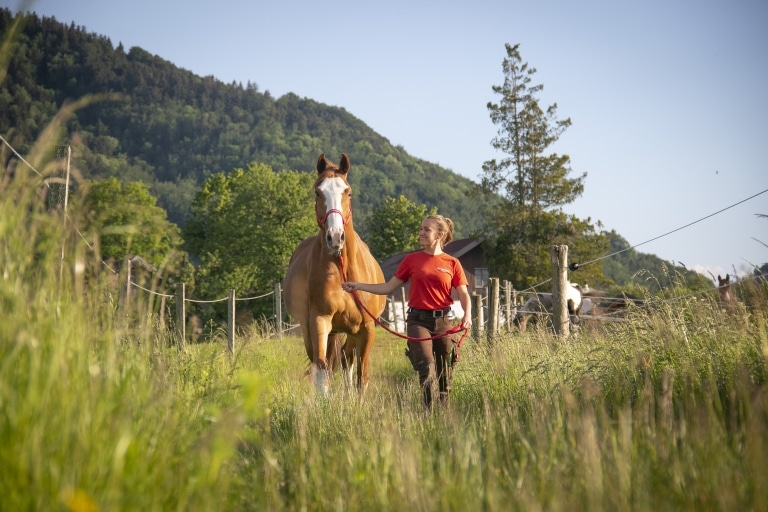
Ziele: Unser Projekt stellt sich daher der Frage, was Lebensqualität bei Pferden bedeutet und wie man dieses Konzept in der Praxis sinnvoll anwenden kann um verantwortungsvolle Entscheidungen für chronisch kranke und alte Pferde zu treffen. Welche Schwierigkeiten begegnen Beteiligte in der Praxis bei der Anwendung und wie gehen sie damit um? Und wie kann man die verschiedenen Perspektiven der Beteiligten gewinnbringend zusammenbringen um gute Entscheidungen für chronisch kranke und alte Pferde zu erreichen?
Ergebnisse/Neue Erkenntnisse: Vor dem Hintergrund einer umfangreichen Literaturrecherche wurden sieben Fokusgruppendiskussionen durchgeführt, die aktuell ausgewertet werden. Dabei haben Pferdebesitzer:innen, Pferdetierärzt:innen, Pferdepfleger:innen, Amtstierärzt:innen und Hufschmied:innen in intensiven Gesprächen ihre Expertise und ihre Erfahrungen zu Entscheidungen für chronisch kranke und alte Pferde und zur Rolle der Lebensqualität der Pferde in diesem Kontext zur Verfügung gestellt.
Ausblick: Wir hoffen mit diesem Projekt die schwierigen Entscheidungen über Therapien und Euthanasie bei chronisch kranken und alten Pferden auf wissenschaftlicher Basis bestmöglich zu unterstützen.
Publikationen:
Long, M., Jenner, F., Kelemen, K., Cavalleri J.-M., Auer, U., Grimm, H., 2022. 53. Case discussions in a clinical ethics support service for equine medicine: a field report. In Transforming Food Systems, Proceedings of the EurSafe 2022, Edinburgh, Scotland, 7–9 September 2022; Bruce, D., Bruce, A., Eds.; Wageningen Academic Publishers: Wageningen, The Netherlands; pp. 344-349. (https://www.wageningenacademic.com/doi/pdf/10.3920/978-90-8686-939-8_53)
Projektleitung: Hon.-Prof. Univ.-Prof. Dr. Herwig Grimm
Sozialkontakte und Zugang zu Ressourcen als Indikatoren des Wohlbefindens und der Lebensqualität von Pferden
Grundlage/Ausgangspunkt: Sozialverhalten ist sowohl eine Ursache als auch eine Folge des Wohlbefindens und der Lebensqualität von Pferden. Da nur enge Gefährten für affiliative Interaktionen innerhalb des persönlichen Raums eines Pferdes toleriert werden, während agonistisches Verhalten durch eine sofortige Vergrößerung der sozialen Distanz nach dem Kontakt angezeigt wird, ist Nähe (und ihre Dauer) ein guter Indikator für soziale Verhaltensmerkmale von Pferden.
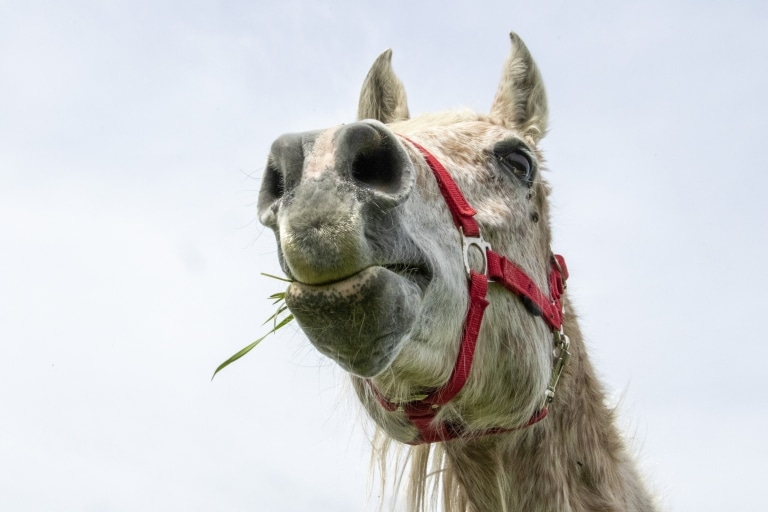
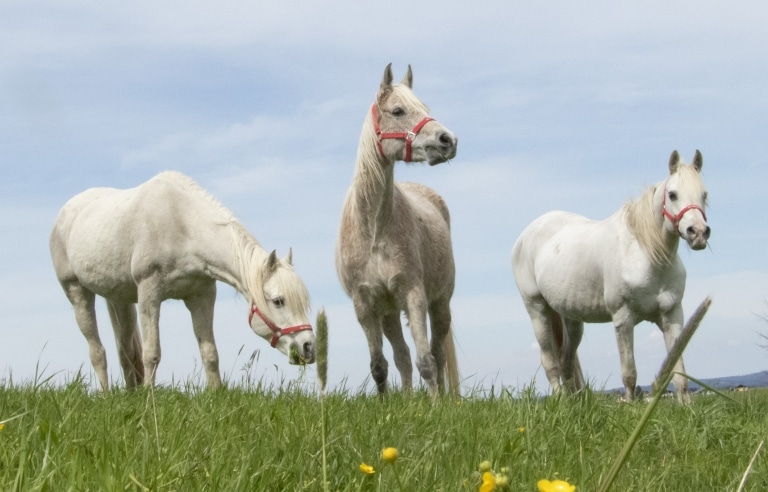
Ziele: Dieses Projekt zielt darauf ab, ein neues, ergänzendes Instrument zur Bewertung der Lebensqualität von Pferden zu entwickeln, um gezielte Interventionen zur Verbesserung der Pferdehaltung sowie der Lebensqualität von Pferden zu ermöglichen. Diese Bewertung beruht auf objektiven und quantifizierbaren Indikatoren sozialer Beziehungen und Interaktionsmuster, der Herdendynamik (Zugang zu Ressourcen wie Futter, Liegeflächen) und der Zeitbudgets für Essen, Ruhen, Aktivität sowie dem Diskomfort –Score.
Neue Erkenntnisse: Im Rahmen der Studie werden die Pferde von Gut Aiderbichl über Jahre regelmäßig mit tragbarem Sensor ausgestattet um:
- die räumliche Nähe zwischen einzelnen Pferden und die Dauer der Nähe zu bestimmen, die für agonistisches und affiliatives Verhalten charakteristisch sind;
- den Zugang der einzelnen Pferde zu gemeinsamen Ressourcen (Futter, Liegeflächen) zu messen;
- das Sozialverhalten und die Zeitbudget von Pferden in Boxen-Einzelhaltung mit Koppelgang in stabilen Gruppen zu Pferden in Offenstallhaltung zu vergleichen um das soziale Kontaktnetzwerk der Pferde unter verschiedenen Haltungsbedingungen zu ermitteln;
- das Sozialverhaltens, die Zeitbudgets und die Diskomfort-Scores zwischen gesunden jungen, gesunden geriatrischen und chronisch lahmen Pferden zu vergleichen, da die Auswirkungen von Alter und chronischen Lahmheiten auf das Sozialverhalten von Pferden unbekannt sind und diese Population ein höheres Risiko für eine schlechte Lebensqualität aufweist;
- den Zusammenhang zwischen dem messbaren Sozialverhalten, den Zeitbudgets und dem Diskomfort-Score mit der Proxy-Bewertung der Lebensqualität zu analysieren.
Ausblick: In dieser Studie etablieren und validieren wir den Einsatz von Proximity Sensoren zur Quantifizierung des Sozialverhaltens bei Pferden und untersuchen den Einfluss verschiedener Haltungsbedingungen und des Gesundheitszustands auf die Sozialität und das Interaktionsnetzwerk von Pferden. Die Einbeziehung sozialer Kriterien als Schlüsselkomponente der Bewertung von Lebensqualität wird es erleichtern, gezielte Interventionen bei Pferden, die Veränderungen in ihrem Sozialverhalten zeigen, zu tätigen. Ebenso bei Herden mit einer hohen Anzahl agonistischer sozialer Interaktionen. Dies kann dazu beitragen die Tierhaltung, das Wohlbefinden und die Lebensqualität der Pferde zu verbessern.
Projektleitung: Priv.Doz. OÄ Dr. Ulrike Auer, Dipl.ACVS Univ.-Prof Dr med.vet. Dipl.ECVS Jenner Florien
